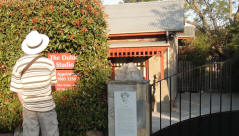In Melbourne we often take things for granted. For
instance every day, thousands of people pass through Kew junction. Few
notice the monument of a bronze bust on a stone base and those who do
possibly dismiss it as yet another minor councillor from the past. After
all, Melbourne is full of dead white males on plinths.
 Similarly, thousands of people a day pass along Burke
Road Malvern and possibly don’t notice the small ’studio’ sign on a
modest house opposite the large park. After all there are lots of
studios around Melbourne. However this deserves closer examination. The
artists who lived and worked there were part of a remarkable generation
who had a major influence on Melbourne’s cultural life. Karl was of
Polish/Austrian/Jewish background and met his wife Slawa - also an artist - in Vienna. Their artistic
careers were progressing well and in fact Karl had sent off a
number of works for exhibition in Paris when the Nazis came to power. A
hasty exit was arranged via Switzerland to Singapore. There on the other
side of the world in a British enclave things ought to be safe. However
because they were travelling on German passports they were deported to
the Tatura Alien Internment Camp in Tatura near Shepparton. As it turned
out that was probably a better alternative to staying for the Japanese
occupation of Singapore and Tatura became a virtual university with its
concentration of highly skilled and educated Europeans. Karl was
released in 1942 to join the Home Guard and he and Slawa were
naturalized in 1946.
Similarly, thousands of people a day pass along Burke
Road Malvern and possibly don’t notice the small ’studio’ sign on a
modest house opposite the large park. After all there are lots of
studios around Melbourne. However this deserves closer examination. The
artists who lived and worked there were part of a remarkable generation
who had a major influence on Melbourne’s cultural life. Karl was of
Polish/Austrian/Jewish background and met his wife Slawa - also an artist - in Vienna. Their artistic
careers were progressing well and in fact Karl had sent off a
number of works for exhibition in Paris when the Nazis came to power. A
hasty exit was arranged via Switzerland to Singapore. There on the other
side of the world in a British enclave things ought to be safe. However
because they were travelling on German passports they were deported to
the Tatura Alien Internment Camp in Tatura near Shepparton. As it turned
out that was probably a better alternative to staying for the Japanese
occupation of Singapore and Tatura became a virtual university with its
concentration of highly skilled and educated Europeans. Karl was
released in 1942 to join the Home Guard and he and Slawa were
naturalized in 1946.
Together with their young daughter Eva they moved into
Acland Street St Kilda and he as a sculptor and she as a painter lived
on the smell of an oil rag - or rather a turpsy rag. There was no point
applying for an arts grant - such things were still 25 years in the
future - but they both could teach and the relatively long holidays allowed them to
pursue their sculpting and painting respectively. Although it has become
fashionable for certain people involved with the arts in Australia to
despise sport (reserving the word ‘games’ as an ultimate putdown) this
was not the case with Karl. He has been Austrian national table tennis
champion and played soccer and tennis at international level while his
daughter reached the quarter finals at Wimbledon. It is not surprising
therefore that his sculpture often exhibits a muscular energy.
The
couple would later move to Malvern where they set up their studio.
In the meantime, a remarkable number of talented
Europeans, many of Jewish background, had been dispersed to Australia as
a result of the war. The entire Vienna Boys Choir was ‘stranded’ here
and many of them went on to make major cultural contributions to
Australian life. The European rigour and mastery of craft formed a
useful counterbalance to the less inhibited (but less well-grounded)
creativity of the locals.
Numbers of the couple’s early works were lost due to the hurried fleeing from the Nazis. However in 1961, some previously unopened crates were opened in a gallery in Paris.
They contained the works Karl had sent off to Paris (and had presumed lost) just before leaving Vienna.
So next time you find yourself near Kew junction wander
over and have a look the memorial. Whoops - it’s starting to rain -
better put up that small foldable umbrella - did you know that the small
foldable umbrella was invented and patented by Slawa? - as I said we
tend to take a lot of things for granted in Melbourne. The Memorial is
Karl’s last work created at the age of 83 and is to Raoul Wallenberg.
Wallenberg, was an architect and businessman who rescued tens of
thousands of European Jews from the Nazis in Hungary (possibly ten times
more than the popularly known Oskar Schindler) and you can find
monuments to him around the world. He is believed to have been
imprisoned and killed by the Russian Communists in 1945 during the
‘liberation’ of Hungary. It is no surprise then that Karl Duldig would
choose this monument as his last public work.
If you would like to see Karl and Slawa’s studio
together with numbers of their works, it is open to the public at the times listed above. Even if the art is not to your taste, we recommend
a visit to remind yourself of a generation that helped make Melbourne
what it is today.
(Since this article was first published, Raoul
Wallenberg has been made Australia's first Honorary Citizen)